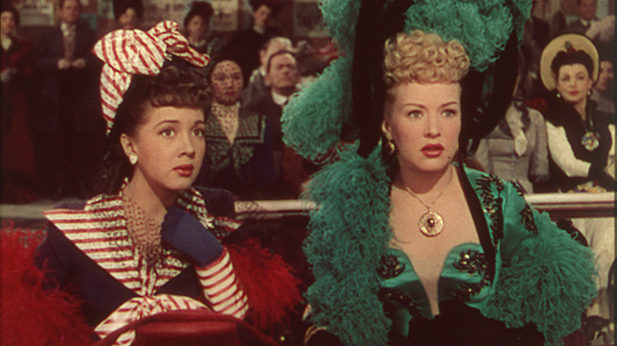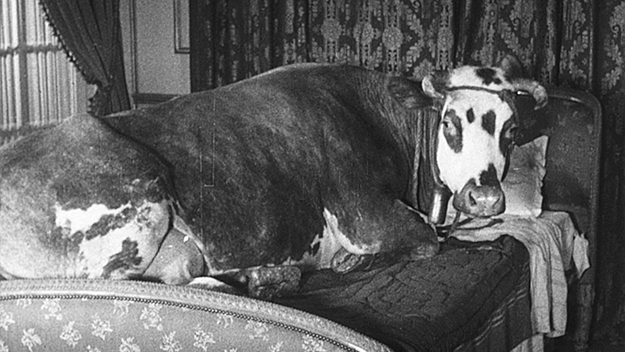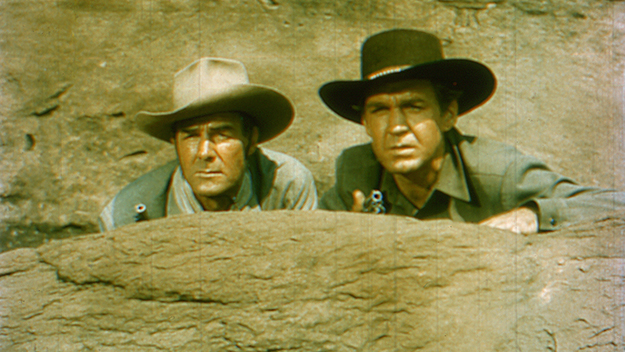The Beautiful Blonde from Bashful Bend (Preston Sturges, 1949) Audiences returning to the George Eastman Museum’s Nitrate Picture Show, which just wrapped its fifth edition, are by now familiar with what makes a weekend of projected silver nitrate prints so special. They know the history of the celluloid stock—phased out in the late ’40s and ’50s due to safety concerns over its intense flammability—and its rather unparalleled look, a gorgeous sheen and nearly three-dimensional depth of field. That mix of danger and beauty, not to mention scarcity (the Eastman remains the only U.S. venue east of the Mississippi certified to project nitrate), makes the seductive appeal of this three-day event tough to deny. While several local Rochester residents come out for the screenings, the Picture Show attracts a healthy contingent of obsessive programmers, critics, enthusiasts, and archivists from across the country for a garbage plate–fueled viewing marathon. Spotting film-centric vanity license plates in the parking lot has become an annual rite of passage. (This year: CINEMA and ROSEBUD.) While most other stops on the classic film festival circuit pride themselves on restoration (nearly all showcasing pristine 4K DCPs scrubbed free of pesky dirt, flaws, and character), Nitrate’s focus is on preservation. In his opening-night remarks, departing Eastman senior curator Paolo Cherchi Usai summed up the mission statement nicely: “I always felt uneasy with the obsession of trying to bring back films to a state that makes people pretend that a print had no history. History is good.” That sentiment informs every aspect of the program: the booklets expressly detail the shrinkage, edge nicks, surface scratches, and splice counts of each 70-plus-year-old print screened. For those used to the corporate-branded, celebrity-worshiping tenor of most American film festivals (even those devoted to older films), there’s a refreshing purity and wonkiness to this whole endeavor. But a fascinating tension has emerged over these last five years of Nitrate: are we here to watch prints, or are we here to watch movies? As with Telluride, this is a festival that doesn’t announce its lineup until opening day; attendees make the trek on the trust of the curators and institution, who rightly aim to strike a balance in the programming. This comes from the desire to not only highlight different kinds of films—this year saw multiple comedies, Westerns, and films noirs on the bill—but also the preservation work of several archives around the globe (UCLA loaned William Wyler’s Counsellor at Law; Finland’s KAVI provided the pastoral romance People in the Summer Night). It’s a tricky act to pull off, especially given the limitations of availability—just how many surviving nitrate prints are still able, and allowed, to be projected? And then there’s the astronomical shipping cost: each reel must be individually wrapped and packaged in sand (to prevent spontaneous combustion), and then insured for an ungodly sum. To my eyes, the 2019 edition was perhaps the most successful yet from an audience-enjoyment perspective, offering a highly pleasurable succession of films without sacrificing the rigor that distinguishes each Picture Show.
L’Age d’Or (Luis Buñuel, 1930) The lineup is always informally divided into two types of selections: the canonized favorites a vast majority of the crowd have seen (but haven’t really seen until they’ve seen them on nitrate), and the obscurities, presented either because the film warrants greater attention or because its print showcases unique qualities. The all-timers this year (in the prime-time Friday and Saturday night slots) were Luis Bunuel’s L’Age d’Or and Alfred Hitchcock’s Rebecca, both screening in copies from the Eastman’s own collection. The former was purchased from a cash-strapped Henri Langlois, and remains the only surviving nitrate print of the film able able to be projected. Though scratched to a nearly Brakhagian degree (“a virtue rather than a liability,” remarked Usai), the image glistens, and the movie itself—erotically charged and hilariously blasphemous—still carries a power to shock nearly nine decades later. The Rebecca print, meanwhile, donated to the Eastman by producer David O. Selznick’s son Daniel, looked as though it had barely ever run through a projector, the sudsy sea-foam and flames of a burning Manderlay registering in a way they never have for this viewer before. Noir’s chiaroscuro photography makes an especially good case for the silvery glimmer of nitrate, and this year featured the diabolical carny huckster parable Nightmare Alley (soon to be remade by Guillermo del Toro) and Dead Reckoning, with Humphrey Bogart as Humphrey Bogart and the great Lizabeth Scott as Lauren Bacall in a story so hard-boiled it teeters deliciously on the edge of self-parody. And while Nitrate of course skews mostly toward black-and-white film, color photography was represented this year by two Westerns: The Beautiful Blonde from Bashful Bend, Preston Sturges’s last American film, and The Nevadan, a Randolph Scott B-programmer by Gordon Douglas. The Beautiful Blonde from Bashful Bend, largely dismissed as crude and unsubtle upon its release, was a revelation: a gloriously, well, crude and unsubtle Western parody, a proto–Blazing Saddles but actually funny, with gags landing with remarkable speed and efficiency. (The anarchic, poker-faced send-up of a climactic Western shootout is worthy of Buster Keaton, and made it that much tougher to watch the genuine article in The Nevadan the next afternoon.) It was Sturges’s first film in Technicolor, shot by Harry Jackson (The Band Wagon) and confirms the director as far more visually accomplished than usually accredited.
The Nevadan (Gordon Douglas, 1950) The other color film was the last title on the program: Powell and Pressburger’s Gone to Earth. Nitrate prints of Archers productions (including Black Narcissus and The Tales of Hoffmann) have been the highlights of past festivals, so it was especially disappointing to have this screening revealed as the secret “Blind Date with Nitrate” at the 11th hour on Sunday afternoon, when many audience members (myself included) have already made plans to skip town and schlep back to their dreary, nitrate-free daily lives far away from upstate New York. My compatriots and I weren’t able to stay and were rather incensed; it’s absurd to have a surprise screening during a weekend where everything is a surprise already, let alone hold this as the final event so out-of-town attendees have no chance to come up with alternate travel arrangements. It left a sour taste after three days of so much sweetness. Still, it’s tough to quibble too much with a festival that so clearly does so much right. The Nitrate Picture Show brings to the spotlight the tireless efforts of the actual human beings keeping the physical history of cinema alive; what other film event calls out the names of the projectionists before every single screening and pauses to give them rounds of applause? Year after year, this is an invigorating labor of love—with an emphasis on both the labor and the love. C. Mason Wells is curator, screenwriter, and head of theatrical sales for Kino Lorber.


